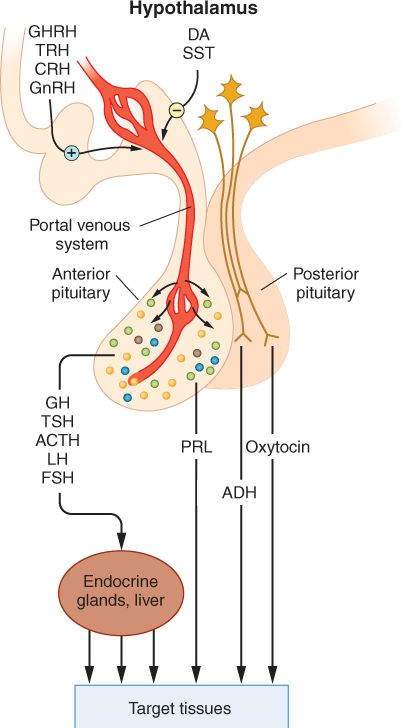High-Yield Terms to Learn
Acromegaly A syndrome of growth hormone (GH) excess in adults that is characterized by abnormal growth of tissues—particularly connective tissue—metabolic abnormalities, and cardiac dysfunction Central diabetes insipidus A syndrome of polyuria, polydipsia, and hypernatremia caused by inadequate production of vasopressin Gigantism A syndrome of GH excess in children and adolescents with open long bone epiphyses that results in excessive height Gonadotropins The 2 anterior pituitary hormones (luteinizing hormone [LH] and follicle-stimulating hormone [FSH]) that regulate reproduction in males and females Insulin-like growth factor-1 (IGF-1) A growth factor that is the primary mediator of GH effects Prolactinoma Pituitary tumor that secretes excessive amounts of prolactin and is associated with a syndrome of infertility and galactorrhea Tocolytics Drug used to inhibit preterm labor (eg, the oxytocin receptor antagonist atosiban; magnesium sulfate; nifedipine;  2 agonists)
2 agonists)
Anterior Pituitary Hormones & Their Hypothalamic Regulators
The hypothalamic and pituitary hormones and their antagonists are often grouped according to the anatomic site of release of the hormone that they mimic or block—the hypothalamus for gonadotropin-releasing hormone (GnRH); the anterior pituitary for growth hormone (GH), the 2 gonadotropins, luteinizing hormone (LH) and follicle-stimulating hormone (FSH), and prolactin; or the posterior pituitary for oxytocin and vasopressin (antidiuretic hormone [ADH]). This chapter focuses on the agents used commonly; it does not discuss the hypothalamic and pituitary hormones that are either not used clinically or are used rarely for specialized diagnostic testing (thyrotropin-releasing hormone [TRH], thyroid-stimulating hormone [TSH], corticotropin-releasing hormone [CRH], adrenocorticotropic hormone [ACTH], and growth hormone-releasing hormone [GHRH]). Hormones of the anterior pituitary are central links in the hypothalamic-pituitary endocrine system (or axis; Figure 37-1). All the anterior pituitary hormones are under the control of a hypothalamic hormone and, with the exception of prolactin, all mediate their ultimate effects by regulating the production by peripheral tissues of other hormones (Table 37-1). Four anterior pituitary hormones (TSH, LH, FSH, and ACTH) and their hypothalamic regulators are subject to feedback regulation by the hormones whose production they control. The complex systems that regulate hormones of the anterior pituitary provide multiple avenues of pharmacologic intervention.
FIGURE 37-1
The hypothalamic-pituitary endocrine system. Hypothalamic factors regulate the release of anterior pituitary hormones. Pituitary hormones either stimulate the release of other hormones or act directly on target tissues. ACTH, adrenocorticotropic hormone; ADH, antidiuretic hormone (vasopressin); CRH, corticotropin-releasing hormone; DA, dopamine; FSH, follicle-stimulating hormone; GH, growth hormone; GHRH, growth-hormone releasing hormone; GnRH, gonadotropin-releasing hormone; LH, luteinizing hormone; PRL, prolactin; SST, somatostatin; TRH, thyrotropin-releasing hormone; TSH, thyroid-stimulating hormone.
(Reproduced, with permission, from Katzung BG, editor: Basic & Clinical Pharmacology, 11th ed. McGraw-Hill, 2009: Fig. 37-1.)
TABLE 37-1 Links between hypothalamic, anterior pituitary, and target organ hormones or mediators.a
Anterior Pituitary Hormone Hypothalamic Hormone Target Organ Primary Target Organ Hormone(s) or Mediator(s) Growth hormone (GH, somatotropin) Growth hormone-releasing hormone (GHRH) (+) Somatostatin (-) Liver, muscle, bone, kidney, and others Insulin-like growth factor-1 (IGF-1) Thyroid-stimulating hormone (TSH) Thyrotropin-releasing hormone (TRH) (+) Thyroid Thyroxine, triiodothyronine Adrenocorticotropin (ACTH) Corticotropin-releasing hormone (CRH) (+) Adrenal cortex Glucocorticoids, mineralocorticoids, androgens Follicle-stimulating hormone (FSH) Luteinizing hormone (LH) Gonadotropin-releasing hormone (GnRH) (+)b
Gonads Estrogen, progesterone, testosterone Prolactin (PRL) Dopamine (-) Breast —
(+), stimulant; (-), inhibitor.
aAll of these hormones act through G protein-coupled receptors except GH and prolactin, which act through JAK/STAT receptors.
bEndogenous GnRH, which is released in pulses, stimulates LH and FSH release. When administered continuously as a drug, GnRH and its analogs inhibit LH and FSH release.
Reproduced, with permission, from Katzung BG, editor: Basic & Clinical Pharmacology, 11th ed. McGraw-Hill, 2009.
Growth Hormone (GH) and Mecasermin
GH
Growth hormone is required for normal growth during childhood and adolescence and is an important regulator throughout life of lipid and carbohydrate metabolism and lean body mass. Its effects are primarily mediated by regulating the production in peripheral tissues of insulin-like growth factor 1 (IGF-1) and 2 (IGF-2).
Somatropin is a recombinant form of human GH that is used in the treatment of GH deficiency in children and adults and in the treatment of children with genetic diseases associated with short stature (eg, Turner’s syndrome, Noonan syndrome, Prader-Willi syndrome). GH treatment also improves growth in children with failure to thrive because of chronic renal failure or the small-for-gestational-age condition. The most controversial use of GH is for children with idiopathic short stature who are not GH deficient. In this group of children, multiple years of GH therapy at great cost and some risk of toxicity results in a small (1-3 inches) average increase in final adult height.
In adults, GH has efficacy in treatment of AIDS-associated wasting and GH deficiency, and it may improve gastrointestinal function in patients who have undergone intestinal resection and have subsequently developed a malabsorption syndrome. GH is a popular component of antiaging programs even though studies in model animal systems have consistently found that analogs of GH and IGF-1 shorten lifespan. GH is also used by athletes for a purported increase in muscle mass and athletic performance and is one of the drugs banned by the Olympic Committee and professional sports associations. Recombinant bovine GH is used in dairy cattle to increase milk production.
Adults generally tolerate GH less well than children. Adverse effects include peripheral edema, myalgia, and arthralgia. Rarely, GH causes intracranial hypertension.
Mecasermin
A small group of children with growth failure unresponsive to GH therapy are deficient in IGF-1 and a binding protein (insulin-like growth factor-binding protein-3) that maintains an adequate half-life of the IGF-1. Mecasermin, a complex of recombinant human IGF-1 and the binding protein, is administered parenterally to children with IGF-1 deficiency. Its most important toxicity is hypoglycemia, which can be prevented by consumption of a snack or meal shortly before mecasermin administration.
Growth Hormone Antagonists
Growth hormone-secreting pituitary adenomas cause acromegaly in adults and, rarely, gigantism in children and adolescents who have not completed their growth phase. Pharmacologic treatment of GH excess seeks to inhibit GH secretion or interfere with GH effects.
Somatostatin Analogs
Stay updated, free articles. Join our Telegram channel

Full access? Get Clinical Tree



